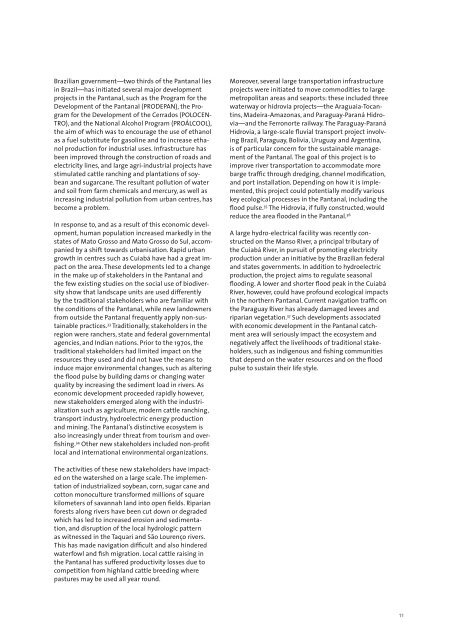Inter-linkages Approach for Wetland Management - UNU-IAS ...
Inter-linkages Approach for Wetland Management - UNU-IAS ...
Inter-linkages Approach for Wetland Management - UNU-IAS ...
Create successful ePaper yourself
Turn your PDF publications into a flip-book with our unique Google optimized e-Paper software.
Brazilian government—two thirds of the Pantanal lies<br />
in Brazil—has initiated several major development<br />
projects in the Pantanal, such as the Program <strong>for</strong> the<br />
Development of the Pantanal (PRODEPAN), the Program<br />
<strong>for</strong> the Development of the Cerrados (POLOCEN-<br />
TRO), and the National Alcohol Program (PROÁLCOOL),<br />
the aim of which was to encourage the use of ethanol<br />
as a fuel substitute <strong>for</strong> gasoline and to increase ethanol<br />
production <strong>for</strong> industrial uses. Infrastructure has<br />
been improved through the construction of roads and<br />
electricity lines, and large agri-industrial projects have<br />
stimulated cattle ranching and plantations of soybean<br />
and sugarcane. The resultant pollution of water<br />
and soil from farm chemicals and mercury, as well as<br />
increasing industrial pollution from urban centres, has<br />
become a problem.<br />
In response to, and as a result of this economic development,<br />
human population increased markedly in the<br />
states of Mato Grosso and Mato Grosso do Sul, accompanied<br />
by a shift towards urbanisation. Rapid urban<br />
growth in centres such as Cuiabá have had a great impact<br />
on the area. These developments led to a change<br />
in the make up of stakeholders in the Pantanal and<br />
the few existing studies on the social use of biodiversity<br />
show that landscape units are used differently<br />
by the traditional stakeholders who are familiar with<br />
the conditions of the Pantanal, while new landowners<br />
from outside the Pantanal frequently apply non-sustainable<br />
practices. 33 Traditionally, stakeholders in the<br />
region were ranchers, state and federal governmental<br />
agencies, and Indian nations. Prior to the 1970s, the<br />
traditional stakeholders had limited impact on the<br />
resources they used and did not have the means to<br />
induce major environmental changes, such as altering<br />
the flood pulse by building dams or changing water<br />
quality by increasing the sediment load in rivers. As<br />
economic development proceeded rapidly however,<br />
new stakeholders emerged along with the industrialization<br />
such as agriculture, modern cattle ranching,<br />
transport industry, hydroelectric energy production<br />
and mining. The Pantanal’s distinctive ecosystem is<br />
also increasingly under threat from tourism and overfishing.<br />
34 Other new stakeholders included non-profit<br />
local and international environmental organizations.<br />
Moreover, several large transportation infrastructure<br />
projects were initiated to move commodities to large<br />
metropolitan areas and seaports: these included three<br />
waterway or hidrovia projects—the Araguaia-Tocantins,<br />
Madeira-Amazonas, and Paraguay-Paraná Hidrovia—and<br />
the Ferronorte railway. The Paraguay-Paraná<br />
Hidrovia, a large-scale fluvial transport project involving<br />
Brazil, Paraguay, Bolivia, Uruguay and Argentina,<br />
is of particular concern <strong>for</strong> the sustainable management<br />
of the Pantanal. The goal of this project is to<br />
improve river transportation to accommodate more<br />
barge traffic through dredging, channel modification,<br />
and port installation. Depending on how it is implemented,<br />
this project could potentially modify various<br />
key ecological processes in the Pantanal, including the<br />
flood pulse. 35 The Hidrovia, if fully constructed, would<br />
reduce the area flooded in the Pantanal. 36<br />
A large hydro-electrical facility was recently constructed<br />
on the Manso River, a principal tributary of<br />
the Cuiabá River, in pursuit of promoting electricity<br />
production under an initiative by the Brazilian federal<br />
and states governments. In addition to hydroelectric<br />
production, the project aims to regulate seasonal<br />
flooding. A lower and shorter flood peak in the Cuiabá<br />
River, however, could have profound ecological impacts<br />
in the northern Pantanal. Current navigation traffic on<br />
the Paraguay River has already damaged levees and<br />
riparian vegetation. 37 Such developments associated<br />
with economic development in the Pantanal catchment<br />
area will seriously impact the ecosystem and<br />
negatively affect the livelihoods of traditional stakeholders,<br />
such as indigenous and fishing communities<br />
that depend on the water resources and on the flood<br />
pulse to sustain their life style.<br />
The activities of these new stakeholders have impacted<br />
on the watershed on a large scale. The implementation<br />
of industrialized soybean, corn, sugar cane and<br />
cotton monoculture trans<strong>for</strong>med millions of square<br />
kilometers of savannah land into open fields. Riparian<br />
<strong>for</strong>ests along rivers have been cut down or degraded<br />
which has led to increased erosion and sedimentation,<br />
and disruption of the local hydrologic pattern<br />
as witnessed in the Taquari and São Lourenço rivers.<br />
This has made navigation difficult and also hindered<br />
waterfowl and fish migration. Local cattle raising in<br />
the Pantanal has suffered productivity losses due to<br />
competition from highland cattle breeding where<br />
pastures may be used all year round.<br />
11

















